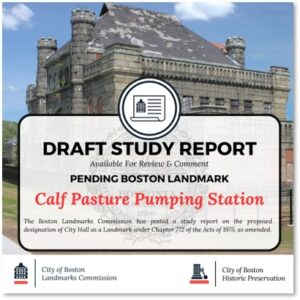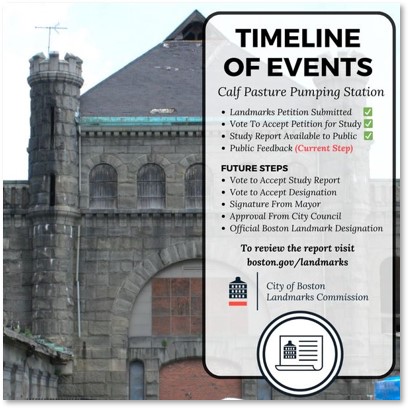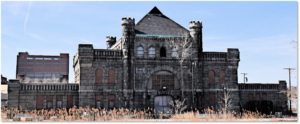It makes me feel good when people respond to something I wrote on The Next Phase Blog. Sometimes they describe how a place I’ve written about affected their lives. Families occasionally reach out with news about a person I’ve mentioned or to thank me about a story that includes them. I feel especially good when an authority or organization includes me on an update. That makes it, you know, official.
The Calf Pasture Pumping Station
 This morning, the Boston Landmarks Commission included me on a Facebook post concerning the status of the Calf Pasture Pumping Station on Columbia Point.
This morning, the Boston Landmarks Commission included me on a Facebook post concerning the status of the Calf Pasture Pumping Station on Columbia Point.
Way back in December of 2019 I published a post on Boston’s old Calf Pasture Pumping Station. After describing its history, architecture, and current condition, I noted that Preservation Massachusetts had named the structure one of the state’s most endangered historic resources and that it was added to the National Register of Historic Places in 1990.
Also, I noted that The Boston Landmarks Commission had accepted the Calf Pasture Pumping Station petition for further study in 2018. That put the building into a process that could eventually designate it as a Boston Landmark.
This morning the BLC informed those of us included as Facebook Followers of a change in status. I perked right up, thinking that a decision had actually been reached. Instead, this is what I read:
“On April 2, 2024, the Boston Landmarks Commission posted a study report on the proposed designation of the Calf Pasture Pumping Station as a Landmark under Chapter 772 of the Acts of 1975, as amended.”
A Change in Status for the Building
That’s right: the only thing that has changed in six years was the report’s status, not an actual landmark designation. It took all that time to check off three items and move on to the fourth. Five more required actions follow in the timeline.
The Facebook post continued:
“Located on Columbia Point in the Dorchester section of Boston, the Calf Pasture Pumping Station Complex consists of three buildings—the Pumping Station, Gate House/Filth Hoist, and West Shaft Entrance— all Romanesque Revival in style and constructed in 1883. The three buildings serviced a then-innovative public sewerage system and remained in continuous use for 85 years.
“The Calf Pasture Pumping Station Complex is historically and architecturally significant at the local, regional, and national levels for its role in the development of a modern, innovative, and comprehensive sewerage system in Boston and as a model for cities nationwide; as an exemplar of late 19th century civic architecture; and as the work of Boston’s first City Architect, George A. Clough, a prolific designer of public buildings. Largely intact and still dramatically prominent in the landscape, the Pumping Station Complex represents significant achievements in technology, social reform, and architectural design in the late 19th century.”
There you have it: the project has reached Step 4 and the study has been accepted.
Public Comments on the Calf Pasture Pumping Station
Now, in this step, we the public get to comment.
“To read the study report and submit a public comment, click here: https://www.boston.gov/…/calf-pasture-pumping-station…”
The city’s website announces that a virtual public hearing has been scheduled for April 23, 2024. “Members of the public can attend this hearing and provide comments there. Please look for the meeting notice in the public meetings notice section of the City website.”
That means we can all attend the virtual hearing on the Calf Pasture Pumping Station’s future. Official progress may seem slow to those of us on the outside, but it’s still progress and I applaud it.
The Calf Pasture Pumping Station on the Tour
For me, however, one thing has changed in the past six years regarding this historic building. I now take busloads of cruise-ship passengers past the Calf Pasture Pumping Station on our way to the Kennedy Library. I always point it out and give a brief summary of its importance. People take pictures. So, there’s that.
My tour passengers sometimes ask me who owns the building and why the owners haven’t fixed it up. They find it difficult to believe that the university is allowing it to fall apart.
Let’s all attend the virtual public hearing and let the city know we care about preserving it. Presumably, if the Calf Pasture Pumping Station gains a Landmark designation, the University of Massachusetts will have to do something about fixing it up. Demolition by neglect is an ugly process.


